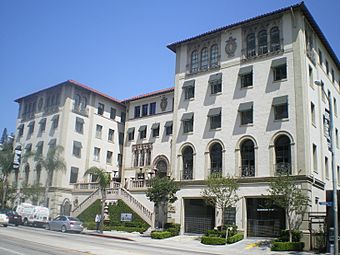Hacienda Arms Apartments facts for kids
Quick facts for kids |
|
|
Hacienda Arms Apartments
|
|

Piazza del Sol, 2008
|
|
| Location | 8439 Sunset Blvd., West Hollywood, California |
|---|---|
| Built | 1927 |
| Architect | Charles Sherman Cobb; Bard, Arthur, & Co. |
| Architectural style | Italian Renaissance Revival-Mediterranean Revival |
| NRHP reference No. | 83003531 |
| Added to NRHP | December 15, 1983 |
The Hacienda Arms Apartments, also known as the Coronet Apartments and Piazza del Sol, is a famous building. It is located on the Sunset Strip in West Hollywood, California.
This four-story building was built in 1927. It was designed in a style that mixes Italian Renaissance Revival and Mediterranean Revival architecture. It first opened as a fancy apartment building. Many people from the entertainment world lived there.
Over time, the building became less popular. In the 1970s, rock star Rod Stewart bought it. He planned to turn it into a luxury hotel. However, a legal problem stopped his plans. In 1983, a fire almost destroyed the building. After a lot of repairs, it reopened in 1986 as the Piazza del Sol. Today, it holds offices for movie companies like Miramax Films. A popular restaurant called Katana is also located there.
Contents
A Home for Hollywood Stars
The building was built in 1927. It cost $382,000 to construct. It was first called the Hacienda Arms Apartments. It quickly became a home for rich Hollywood families.
Many movie actors lived at the Hacienda Arms. These included Marie Dressler, James Dunn, and Loretta Young. Other famous residents were Jeanette MacDonald and child star Leon Janney. Film composers Josiah Zuro and Oscar Potoker also lived there.
Changes Over the Years
In 1940, the famous Ciro's night club opened right next door. Around this time, the building became known as the Coronet Apartments.
From the 1940s to the 1970s, the building changed owners many times. It also started to lose its fancy reputation. The Los Angeles Times newspaper said in 1983 that its decline was like "the decline of Hollywood." It had a quiet history in the 1950s and 1960s.
Some of the sales during this time include:
- In 1941, G.E. Kinsey bought the Coronet.
- In 1950, K.L.M., Inc., sold it to Lee and Victor S. Herman.
- In 1952, Mr. and Mrs. Isidor Tumarkin bought it.
- Frank Sennes, who owned Ciro's, bought the building in 1960.
Sennes mentioned that in the 1960s, "a lot of hippies" lived there. He later emptied the building in the late 1970s. He planned to fix it up.
Rod Stewart's Time and a Big Fire
Rock star Rod Stewart bought the building in the late 1970s. He had a partner named Barry Monzio. Stewart put a lot of money into the building. He wanted to turn the empty building into a fancy European-style hotel.
But the costs grew very high. Stewart and Monzio then had a big legal disagreement. The renovation work stopped. Stewart eventually became the only owner of the building.
In April 1982, Stewart was robbed at gunpoint outside the building. This happened in the middle of the day. The robber stole Stewart's Porsche Carrera car.
In July 1983, the Coronet building was empty. A fire almost completely destroyed it. The inside of the building was burned out. The outside was also badly damaged. Investigators thought the fire was set on purpose. It started in three different places. Its fast spread suggested someone used a flammable liquid to help it burn. Some reports said "vagrants" living in the building might have caused the fire.
Becoming a Historic Landmark
The building was designed in an Italian Renaissance revival style. People said it looked like a "classic Italian villa." After the fire in 1983, the Los Angeles Conservancy worked to make it a historic site.
Ruthann Lehrer, from the Conservancy, said the building was "a beauty." She noted it was "palatial," like a "European palace." The application to add the building to the National Register of Historic Places described its look. It had a cream-and-tan plaster front with decorations. It also had a "grand entrance stairway and fountain." The building still has its original Italian marble, stonework, and wrought iron. It was added to the National Register in December 1983.
The Piazza del Sol Today
Before the 1983 fire, a company called Westcap Financial Group agreed to buy the building. They paid $4.2 million for it. Westcap still bought the building even after the fire.
Westcap changed the building into luxury office spaces. They also changed its name to the Piazza del Sol. In 1986, the West Hollywood Chamber of Commerce gave the remodeled building an award for its architecture.
Today, the Piazza del Sol is a "Class A Office Building." This means it is a very high-quality office building. It offers many different office sizes. Several movie production companies have offices there. These include Miramax Films and The Film Department.
The famous restaurant Katana Robata & Sushi Bar is also in the building. Ryan Seacrest and Tori Spelling are part owners of Katana. It serves "rustic Japanese fare" and sushi. Newsweek magazine called Katana "so hip it hurts" in 2004. They suggested visitors "wear disaffected black" and sit outside. This way, they can watch the busy Sunset Strip.
Images for kids






